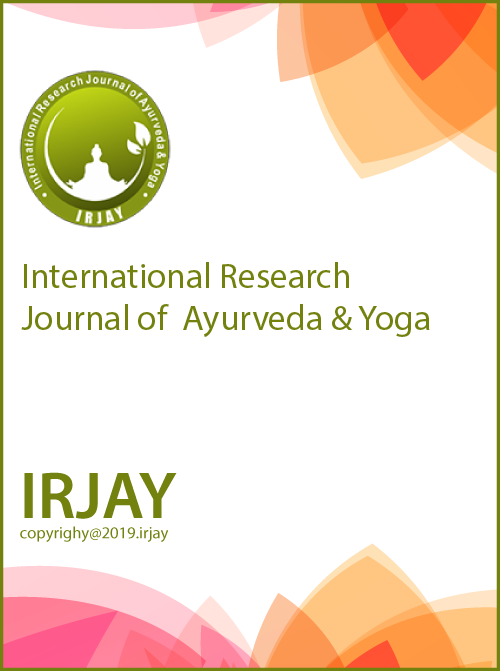Theoretical Secrets of Ayurveda-Review
DOI:
https://doi.org/10.48165/IRJAY.2025.80104Keywords:
Allopathy, Ayurveda, Homeopathy, Naturopathy, Unani, SiddhaAbstract
Background: Almost everyone must have experienced that in this world, not only humans, but even the smallest creatures always try to avoid suffering and strive to attain happiness. Keeping this fact in mind we can say that ever since the creation of the universe, man has been making efforts to fulfill natural desires such as hunger, thirst, and sleep and to get rid of physical diseases. Ayurveda first emerged in this sequence. Nowadays we use many of medical methods such as Allopathy, Homeopathy, Naturopathy, Unani, and Siddha but Ayurvedic system is settled in our hearts. These days everyone’s inclination is increasing towards Ayurveda. Ayurveda Shashtra not only protect the health of a healthy person but also cure the disease. Ayurveda is the only medical science in the whole world which focuses more on Pathya Apathya than the treatment and gives more importance in removing the cause of the disease. Aim: The primary aim of Ayurvedic therapy is to identify the root cause of an illness. Its therapeutic methods are classified into four categories as Prakrutisthapna Chikitsa (health maintainance), Rasayana Chikitsa (restoration of normal function), Roganashani Chikitsa (disease cure), and Naishthiki Chikitsa (spiritual approach). Materials and Methods: An extensive review of Ayurvedic literature, along with its associated commentaries, has been undertaken. In addition, contemporary medical science textbooks have been referenced as sources for this discussion. Result: Ayurveda is the art of living a balanced life, as it not only offers treatments and understanding of diseases but also imparts comprehensive knowledge essential for leading a fulfilling life. Finding the cause of an illness is the basic goal of Ayurvedic therapy. Discussion and Conclusion: Ayurveda is widely recognized as one of the oldest traditional medical systems in the world. The ancient knowledge within this traditional medical system remains largely unexplored. A significant obstacle to the convergence of these systems, aside from other challenges in developing plant-based medicines, is the limited understanding of the differences and similarities in their theoretical principles. The review seeks to highlight the ancient history of Ayurveda. This will assist budding scholars, researches, and practitioners in gaining a deeper understanding of traditional medical systems, fostering the strengthening of shared aspects, and addressing challenges to achieve their global acceptance and harmonization.
Downloads
References
Shastri KA. Sushrutra samhita, Sutrasthana, 1/23. Varanasi: Chaukhambha Sanskrit Sansthan; 2017. p. 8.
Sastri K, Chaturvedi GN. Charak samhita, Sutrasthana, 1/42. Varanasi: Chaukhambha Bharati Academy; 2017. p. 13.
Sastri K, Chaturvedi GN. Charak samhita, Sutrasthana, 1/41. Varanasi: Chaukhambha Bharati Academy; 2017. p. 13.
Sastri K, Chaturvedi GN. Charak samhita, Sutrasthana, 30/26. Varanasi: Chaukhambha Bharati Academy; 2017. p. 587. 5. Sastri K, Chaturvedi GN. Charak samhita, Sutrasthana, 1/15. Varanasi: Chaukhambha Bharati Academy; 2017. p. 7.
Shukla AV, Tripathi RD. Charak samhita, Chikitsasthana, 1-4/57. New Delhi: Chaukhamba Sanskrit Pratishthan; 2010. p. 45. 7. Shukla AV, Tripathi RD. Charak samhita, Chikitsasthana, 1-4/58. New Delhi: Chaukhamba Sanskrit Pratishthan; 2010. p. 45. 8. Sastri K, Chaturvedi GN. Charak Samhita, Sutrasthana, 11/32. Varanasi: Chaukhambha Bharati Academy; 2017. p. 226. 9. Sastri K, Chaturvedi GN. Charak Samhita, Sutrasthana, 11/35. Varanasi: Chaukhambha Bharati Academy; 2017. p. 227. 10. Sastri K, Chaturvedi GN. Charak samhita, Sharirsthana, 1/102.
Shastri KA. Sushrutra samhita, Sutrasthana, 15/3. Varanasi: Chaukhambha Sanskrit Sansthan; 2017. p. 73.
Sastri K, Chaturvedi GN. Charak samhita, Sutrasthana, 20/6. Varanasi: Chaukhambha Bharati Academy; 2017. p. 395. 13. Srivastava SS. Sharngadhar samhita, Madhyam khand, 8/19-21. 4th ed. Varanasi: Chaukhambha Orientalia; 2005. p. 21.
Srivastava SS. Sharngadhar samhita, Madhyam khand, 7/45-49. 4th ed. Varanasi: Chaukhambha Orientalia; 2005. p. 201.
Sastri K, Chaturvedi GN. Charak samhita, Sutrasthana, 28/45. Varanasi: Chaukhambha Bharati Academy; 2017. p. 575. 16. Sharma S, editor. Astangasamgraha, Sanskrit commentary by Indu, Sutrasthana, 1/32-33. Varanasi: Chowkhamba Sanskrit Series Office; 2006. p. 8.

